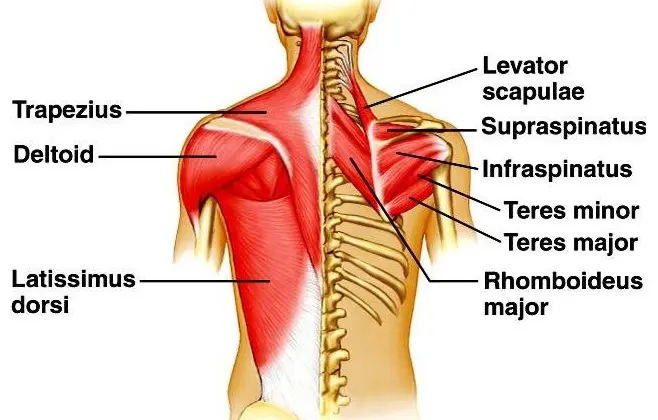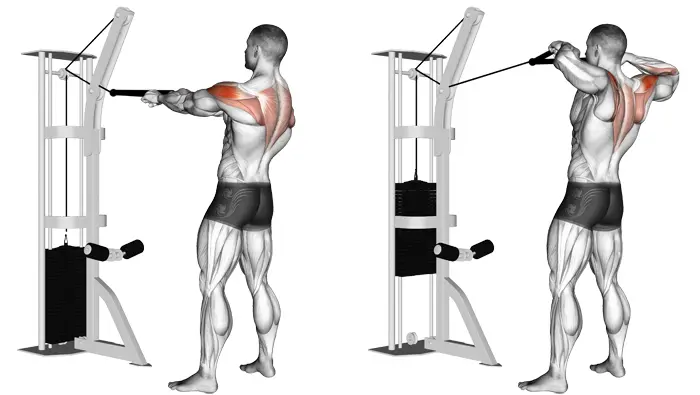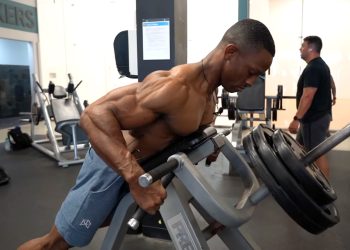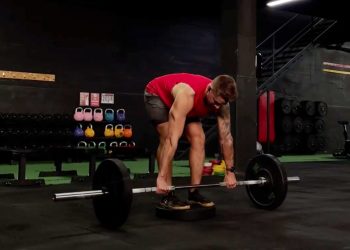There is perhaps no better exercise for your posterior deltoid and back than the cable rear delt fly. If you put all the muscle groups in order of importance, most bodybuilders would place the rear or posterior deltoids at the bottom of the list.
The rear delts are a small muscle, and yet it could be argued that they’re one of the most important. When properly developed, the rear link in with your lats, traps, and rhomboids together to create an impressive-looking back.

As well as being important for aesthetics, the rear delts play a crucial role in the health and function of your shoulder joints. Weak rear delts are a leading cause of shoulder pain.
Unfortunately, the rear delts aren’t just out of sight and out of mind. They’re often undertrained simply because they aren’t involved in all that many upper body exercises.
The anterior deltoid, which opposes the rear deltoid, is involved in all chest exercises and shoulder pressing exercises. A lot of lifters also train this muscle with dumbbell, barbell, and front raises. It’s rare to find a bodybuilder with underdeveloped anterior delts.
In contrast, the rear deltoid is only really active during pulling exercises with your arms raised, e.g., wide-grip bent-over rows and face pulls. So, if you want to train your rear delts, you have to do so more purposely.
Level Up Your Fitness: Join our 💪 strong community in Fitness Volt Newsletter. Get daily inspiration, expert-backed workouts, nutrition tips, the latest in strength sports, and the support you need to reach your goals. Subscribe for free!
There are several effective ways to train your posterior deltoids, but the rear delt cable fly is one of the best.
In this article, we explain why and how to do this exercise and reveal the ten best variations and alternatives.
Cable Rear Delt Fly – Muscles Worked
Technically, the rear delt cable fly is an isolation exercise. That means movement only occurs at one joint. However, despite being a relatively straightforward movement, the rear delt cable fly affects several important muscles:
Posterior deltoid – located on the back of your shoulder joint, the posterior deltoid is responsible for horizontal shoulder extension and shoulder extension with your arm lowered. The rear deltoid is usually the least well-developed of the three deltoid heads, with the others being the anterior (front) and medial (side).
Trapezius – known as the traps for short, this is the large kite-shaped muscle of the upper back. Rear delt cable flys hit the middle fibers of the traps, which are responsible for pulling your shoulder blades back and together in a movement called retraction.
Rhomboids – located between the shoulder blades and beneath the trapezius, the rhomboids also pull your shoulders back and together in retraction. The mid traps and rhomboids are critical postural muscles, and strengthening them can help prevent slouching.
Triceps brachii – usually known simply as the triceps, this three-headed arm muscle works with the rear delts to extend your arm backward. However, while you may feel your triceps working during rear delt cable flys, this is definitely more of a shoulder exercise than an arm builder.
Rotator cuff – the rotator cuff is a group of muscles and tendons that keep the shoulder joint stable. These muscles also allow the shoulder to rotate safely. It’s made up of four muscles: the supraspinatus, infraspinatus, teres minor, and subscapularis. While not a member of the rotator cuff group, teres major is also involved during rear delt cable flys.
How to Do Cable Rear Delt Flys
Get more from cable rear delt flys while keeping your risk of injury to a minimum by following these guidelines:
- Attach D-shaped handles to a high cable crossover machine. Alternatively, you can grip the ends of the cables.
- Take the left cable in your right hand and the right cable in your left hand.
- Step back and extend your arms so the cables cross at about eye level. Extend but do not lock your elbows. Pull your shoulders down and back.
- Keeping your elbows slightly bent but rigid, open your arms and draw them back and slightly downward.
- Bring your arms in and together to return to the starting position.
- Continue for the required number of reps.
This exercise is best done using light to moderate weights and medium to high reps. It does not work well with heavy weights and low reps.
Cable Rear Delt Fly Benefits and Drawbacks
Are you unsure if rear delt cable flys deserve a place in your workouts? Weigh up these benefits and then make your decision:
Better posture – posture is the alignment of your joints, and it can be good or bad. The pull of gravity, combined with too much time sitting and too much chest training, means that a lot of lifters have poor posture. Adding cable rear delt flys to your upper body workouts can help fix your slouch.
A straightforward exercise – while there are other rear delt exercises you can do, cable rear delt flys are one of the simplest. This exercise is easy to learn, quick to master, and ideal for beginners.
No lower back stress – unlike some freeweight posterior deltoid exercises, rear delt cable flys are done in a standing position. As such, there is very little lower back stress to worry about. This exercise is suitable for most lifters, even those suffering from low back pain.
The perfect superset with cable crossovers – rather than just rest between sets of cable crossovers for your chest, why not alternate with sets of cable rear delt flys? This makes better use of your time and ensures that your upper body workout is balanced.
While cable rear delt flys are a mostly beneficial exercise, there is also a drawback to consider:
You need access to a cable crossover machine! – while most gyms have cable crossover machines, you may not have access to one if you train at home or in a garage gym. However, there is no need to neglect your rear delts; there are plenty of non-cable machine alternatives you can do instead.
10 Best Cable Rear Delt Fly Variations and Alternatives
Cable rear delt flys are a highly effective shoulder and upper back exercise, but that doesn’t mean you need to do them all the time. There are several variations and alternatives you can use to keep your workouts productive and interesting:
1. Single-arm cable rear delt fly
Training each arm independently may seem like a waste of time, but you will probably find that you can lift more weight or do more reps compared to the two-armed version. You should also find that your mind-muscle connection is stronger. This is also a good option if you can’t use a cable crossover machine but still have access to a single high cable device.
How to do it:
- Attach a D-shaped handle to a pulley machine set to shoulder height. Hold the handle with your furthest hand. Raise your arm to shoulder height, elbow slightly bent, shoulder down and back, and core braced.
- Without bending your elbow further, extend your arm out and back and then return to the starting position.
- Continue for the desired number of reps and then switch arms. Do the same number of reps on both sides.
2. Bent-over cable rear delt fly
This exercise is basically the same as regular standing cable rear delt flys. Still, some people prefer it and find it more comfortable. However, make sure you hinge from the hips rather than round your lower back, as doing so can lead to injury.
Level Up Your Fitness: Join our 💪 strong community in Fitness Volt Newsletter. Get daily inspiration, expert-backed workouts, nutrition tips, the latest in strength sports, and the support you need to reach your goals. Subscribe for free!
How to do it:
- Attach D-shaped handles to a low cable crossover machine. Alternatively, you can grip the ends of the cables.
- Take the left cable in your right hand and the right cable in your left hand.
- Standing with your feet about shoulder-width apart and your knees slightly bent, bend over until your upper body is almost parallel to the floor.
- Keeping your elbows slightly bent but rigid, open your arms and draw them back to form a T-shape with your body.
- Bring your arms in and together to return to the starting position.
- Continue for the required number of reps.
- This exercise can also be performed using one arm at a time, i.e., a single-arm bent-over cable rear delt fly.
3. Bent-over reverse dumbbell fly
No cable crossover machine? No problem! You can work your rear delts with a pair of good old-fashioned dumbbells! You can do bent-over reverse dumbbell flies standing, seated, or prone on an exercise bench.
Regardless of the option you choose, this is an effective if somewhat challenging posterior deltoid exercise. Don’t go too heavy, or you’ll end up using your back more than your dear delts.
How to do it:
- With a dumbbell in each hand, position your upper body, so it’s roughly parallel to the floor. Let your arms hang straight down from your shoulders. Turn your wrists so your palms are facing inward. Pull your shoulders down and back.
- Keeping your elbows slightly bent but rigid, open your arms and raise the dumbbells until your arms form a T-shape.
- Lower the weights back to the starting position and repeat.
4. Reverse pec deck
The reverse pec deck guides your movements, so you are free to focus on pushing your rear delts and upper back to their limit. This is a valuable exercise for bodybuilders looking to maximize hypertrophy. Like reverse cable crossovers and regular cable crossovers, this exercise makes a great superset with the pec deck done in the usual way.
How to do it:
- Rotate and lock the handles to the rear. Sit with your chest against the backrest. Reach forward and grip the handles with a neutral or overhand grip. Pull your shoulders down and back and brace your core.
- Keeping your elbows slightly bent but rigid, open your arms and extend them backward until your hands are level or slightly behind your shoulders.
- Return to the starting position and repeat.
5. Prone incline dumbbell press
Most pressing exercises work your anterior deltoids more than your rear delts. That all changes when you do prone incline dumbbell presses. This exercise is much more challenging than it looks, so don’t go too heavy too soon!
How to do it:
- Set an incline bench to 45 degrees. With a dumbbell in each hand, lie face down on the bench. Raise the dumbbells up to your shoulders and pull your shoulders down and back.
- Press the weights forward and up so your arms form a straight line with the rest of your body.
- Lower the weights back to your shoulders and repeat.
6. Cable supine reverse fly
The cable supine reverse flye is an effective isolation exercise for the posterior deltoids. Done face up on a flat bench, it provides lots of support for your lower back and also stops you from cheating as you cannot use your legs or upper body to help raise the weight.
How to do it:
- Place a flat bench between two high pulleys.
- Lie on the bench while holding the right pulley handle in your left hand and the left handle in your right hand.
- Keeping your arms perpendicular to your body and your elbows slightly bent, pull your arms apart and out to the sides.
- Slowly return to the starting position and repeat for the desired number of reps.
7. Band pull-apart
If there is one rear delt exercise that every lifter should do, it’s band pull-aparts. Keep a resistance band in your gym bag and do them as part of your upper body warm-up or between sets of bench presses.
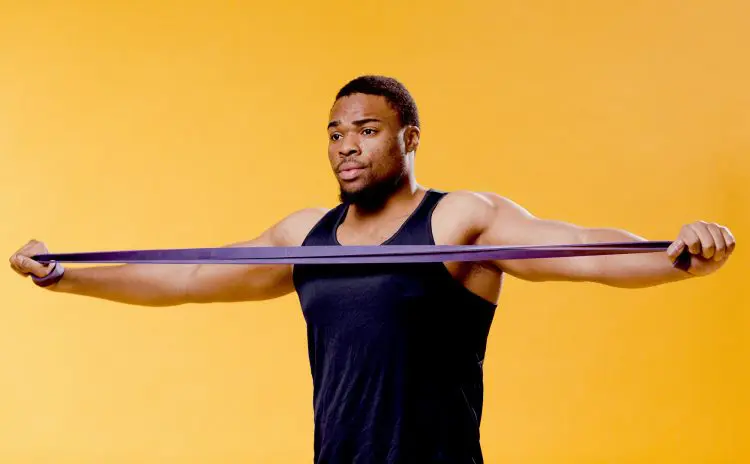
You can even do this exercise at home to break up long periods of sitting. Band pull-aparts are THE most excuse-free way to train your rear delts and improve your posture.
How to do it:
- Seated or standing, hold a resistance band with an overhand, shoulder-width grip. Raise your arms out in front of you. Bend your arms slightly and pull your shoulders down and back.
- Open your arms and stretch the band out across your chest.
- Return to the starting position and repeat.
8. Face pulls
Face pulls target your entire upper back, i.e., the mid-traps, rhomboids, AND posterior deltoids. They’re an excellent postural exercise and one that could add some thickness to your upper back muscles. Face pulls are also good for your shoulder health and could help ward off shoulder joint pain.
However, to get the best possible results, make sure you keep your arms up and really drive your elbows back. If you don’t, you could end up using your lats more than your rear delts and traps.
How to do it:
- Attach a rope handle to a cable pulley set to about chest height.
- Stand with your feet hip-width apart and grab both sides of the handle using a neutral grip. Place one foot in front of the other for balance if necessary.
- Keeping your elbows level with your shoulders, bend your arms and pull the rope toward your face, contracting your rear deltoids as you pull the ends of the handle apart.
- Straighten your arms and repeat for the desired number of reps.
Related: Best Face Pull Alternatives
9. Wide grip incline rows
No barbell, cable machine, or resistance band? No problem! You can train your posterior deltoids using just your body weight for resistance. Inverted rows are typically thought of as a lat exercise but, done with a wider grip, they’re also an excellent move for building the posterior deltoids.
Just make sure you pull your chest to the bar to fully engage your rear delts. If your elbows drop, your lats will end up doing more work than they should.
How to do it:
- Place a barbell in a squat rack at about waist height. Sit on the floor beneath the bar. Reach up and hold it with an overhand, slightly wider than shoulder-width grip.
- Lean back so your arms are straight and lift your hips off the floor. Your legs and body should form a straight line.
- Bend your arms and pull your chest up to the bar, squeezing your shoulders down and back.
- Extend your arms and repeat.
- Make this exercise harder by placing your feet on an exercise bench or easier by raising the bar to lessen the angle of your body.
10. Rear delt dumbbell rows
This dumbbell row variation works your rear deltoids, middle trapezius, rhomboids, and biceps instead of the more usual lats. The trick is to keep your elbows up and away from your body, so your arms are abducted and perpendicular to your body.
Your lats will take over if you let your elbows drift down toward your sides, so KEEP ‘EM UP!
How to do it:
- Sit on the end of an exercise bench with a dumbbell in each hand. Hinge forward from the hips and lower your chest toward your legs. Let your arms hang down from your shoulders. Rotate your wrists so that your hands are in the pronated or palms down position.
- Leading with your elbows, pull the weights up and out so your upper arms are perpendicular to your upper body. Keep your wrists straight and pull your shoulders down and back.
- Extend your arms and repeat.
- You can also do this exercise while standing, i.e., bent-over rear delt dumbbell rows.
More Back Exercises:
- Cable Rear Delt Row
- Dumbbell Rear Delt Row
- Charles Glass Shares a Tip On How to Achieve a Bigger Back
- Thoracic Extensor Exercises for A Stronger Upper Back
- 13 Best Cable Machine Exercises for A Bigger Back
- Mike O’Hearn Detail-Focused Back Workout
- The 7 Best Lower Back Exercises + Workout
- Build Bigger, More Muscular Back in Less Time
- The Kettlebell Alternating Row Exercise Guide and Videos
- Best Landmine Exercises for Building Muscle Mass and Strength
- Best Cable Back Exercises & Workouts to Level Up Your Training
- Best Dumbbell Back Exercises and Workouts
- Best Back Exercises at Home + Workout
Cable Rear Delt Fly – Wrapping Up
There are three deltoid heads – anterior, medial, and posterior – and they all need to be trained pretty equally to build an aesthetically pleasing and structurally solid upper body.
There are plenty of rear deltoid exercises to choose from, but the cable rear delt fly is among the best. You can do it as part of your shoulder workout or when you train your back.
Regardless of when you do it, this exercise will help strengthen and build your underused, underdeveloped posterior deltoids, and it deserves a place in your workout library.
Interested in measuring your progress? Check out our strength standards for Bench Press, Face Pull, Cable Fly, and more.

